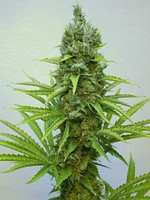
Photo reflects leaf cupping and instances of
tip burn here and there, caused by high
temperatures from a HPS lamp. |
Quite often I hear groans from folks having
leaf problems - ?Help, my leaves are cupping and
the leaf edges are turning brown!?, or, ?My
plant's leaf tips are curling down and turning
black ....what's wrong?? Unless insect damage has
occurred or the plant is suffering from a severe
case of calcium deficiency, the plant is trying to
tell you that it is water stressed. It's hard to
tell *exactly* what the culprit is, and
unfortunately the ?solution? the grower chooses
many times is not the right one. A mis-diagnosis
only serves to make matters worse by promoting
further decline. I?ll try to cover some of the
more common causes that can induce these common
symptoms and try to offer a few simple solutions.
The ultimate and correct solution is in the hands
of the grower.
1. Over-fertilizing
- the most common cause of leaf cupping aka leaf
margin rolling, leaf margin burn, and leaf tip
curl/burn is the overzealous use of too much plant
food in relationship to factors such as plant
vigor and rate of growth. The first unit of a
plant to show moisture stress is the leaf at its
margins and/or tips, reflected by margin rolling
(cupping) or burning. A hard, crispy feel to the
leaf frequently occurs as well, as opposed to a
soft and cool feel of a happy leaf. When you have
a high concentration of salts in solution (or in
the root medium) compared to lower salinity levels
found in the plant?s tissue, water is actually
drawn out of the plant across the root gradient in
order to fix the ppm imbalance. IOW, this is a
natural, osmotic response that serves to equalize
salinity levels on both sides of the root?s
epidermal gradient. Back off on the amount and/or
frequency of plant food. Too much plant food can
also burn the roots, especially the sensitive root
tips, which then creates another set of problems.
Note for the bio folks - as soil dries, the
concentration of the remaining salts rises further
exacerbating the problem.
2. High
Heat - the plant is losing water via it?s
leaves faster than what can be replaced by the
root system. The leaf responds by leaf margin
cupping or rolling (up or down) in order to
conserve moisture. A good example is reflected by
the appearance of broad-bladed turf grass on a hot
summer day, high noon, with low soil moisture
levels - the leaf blade will roll in and the grass
will take on a dull, greyish-green appearance.
Upon sunrise when moisture levels have returned to
normal, the leaf blade will be flat. Lower the
heat and concentrate on developing a large, robust
root system by practicing sound plant culture. An
efficient and effective root system will go a long
way to prevent heat induced leaf dessication and
leaf margin curling. One short episode of high
heat is enough to permanently disable or destroy
leaf tissue and cause a general decline in the
leaves affected, which often occurs to leaves
found at the top of the plant located near HID
lamps. The damaged leaf (usually) does not fully
recover, no matter what you do. Bummer in the
summer. One can only look to new growth for
indications that the problem has been corrected.
3. High Light - yes, it?s true, you
can give our faves too much light. Cannabis does
not receive full sun from sunrise to sunset in its
natural state. It is shaded or given reduced light
levels because of adjacent plant material, cloudy
conditions, rain, dust, twilight periods of early
morning and late afternoon, and light intensity
changes caused by a change in the seasons. Too
much light mainly serves to bleach out and destroy
chlorophyll as opposed to causing leaf cupping,
but it often goes hand-in-hand with high heat for
indoor growers. Again, back off on the light and
concentrate on developing/maintaining an efficient
and robust root system.
4.
Overwatering - this practice only serves to
weaken the root system by depriving the roots of
proper gas exchange. IOW, the roots are not
getting enough oxygen which creates an anerobic
condition causing root decline and root rot with
the end result showing up as leaf stress, stunted
growth, and in severe cases, death. Alot of
times folks think the plant is not getting enough
plant food (which it can't under such adverse
conditions), they add more nutes for a "curative",
and just add insult to injury.
5.
Underwatering - not only is the plant now
stressed due to a low supply of adequate moisture,
but carbohydrate production has been greatly
compromised (screwed up). Step up the watering
frequency, and if need be, organic growers may
need to water from the bottom up until moisture
levels reach a norm throughout the medium. If the
pot feels light to the lift - it?s time to water.
Don?t wait until the soil pulls away from the
sides of the pot or leaves droop before you water.
And of course, leach once in a while to get rid of
excess salts.
Happy gardening,
Uncle
Ben |